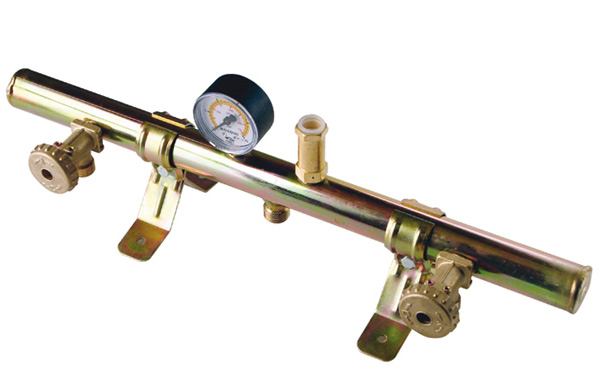Installation groups and their use in gas systems
Tube-shaped installation groups can unite multiple cylinders in series between them and ensure a correct view of pressure

The LPG control units are necessary and fundamental components within a system that conveys these gases. In fact, they allow the regulation and management of the cylinders, also allowing a control of the gas flow rates in relation to the need for use.
The most used material for the production of these components is brass, an alloy of copper and zinc which allows to obtain excellent mechanical properties combined with high corrosion resistance. These characteristics are particularly important for this type of application and allow to obtain a prolonged life of the component. Furthermore, as in all alloys, by modifying the percentage of one or the other main component, in addition to using further additions of alloy elements, it allows you to act on the mechanical characteristics and modify them in relation to the application.
The control units are often accompanied by devices necessary for correct operation. In particular, the most common are:
1. Manometers: devices necessary for measuring the pressure value of the conveyed gas. They allow control and work in synergy with the other parties to manage and obtain an ideal value.
2. Pressure reducers and regulators: thanks to these components, it is possible to reduce the pressure of the gas coming out of the cylinder to allow safer and more efficient transport, avoiding load losses during the journey between the cylinder and the user.
3. Valves: help to manage the flow and block the flow if necessary. They can also be safety valves that allow you to avoid problems related to safety.
The most used material for the production of these components is brass, an alloy of copper and zinc which allows to obtain excellent mechanical properties combined with high corrosion resistance. These characteristics are particularly important for this type of application and allow to obtain a prolonged life of the component. Furthermore, as in all alloys, by modifying the percentage of one or the other main component, in addition to using further additions of alloy elements, it allows you to act on the mechanical characteristics and modify them in relation to the application.
The control units are often accompanied by devices necessary for correct operation. In particular, the most common are:
1. Manometers: devices necessary for measuring the pressure value of the conveyed gas. They allow control and work in synergy with the other parties to manage and obtain an ideal value.
2. Pressure reducers and regulators: thanks to these components, it is possible to reduce the pressure of the gas coming out of the cylinder to allow safer and more efficient transport, avoiding load losses during the journey between the cylinder and the user.
3. Valves: help to manage the flow and block the flow if necessary. They can also be safety valves that allow you to avoid problems related to safety.
Types of control units for LPG gases in the Gnali Bocia catalog
Within the Gnali Bocia catalog you can find various types of control units for LPG gas, suitable for different types of applications. In particular, you can find models that vary in relation to the number of attacks with the cylinders: devices are available equipped with a single attack, with two attacks but also with three attacks. Furthermore, there are essentially two main types of control units:
- Mini control units: they can be of two main variants, namely the M model and the Y model;
- Tubular control units: characterized by the presence of a tube on which the cylinders are connected;
In addition to this macro-division, within the single type there are a series of variants characterized by the presence of additional devices such as, for example, pressure gauges and pressure reducers or regulators.
As in all application choices, it is necessary to choose the most suitable model for the application to be created, making a trade-off between existing accessories and costs. The correct choice represents the optimal starting point for an efficient and lasting use over time, which allows to limit the risks associated with the use of gas both as regards the systems in which these components are inserted and for the people who are nearby.
- Mini control units: they can be of two main variants, namely the M model and the Y model;
- Tubular control units: characterized by the presence of a tube on which the cylinders are connected;
In addition to this macro-division, within the single type there are a series of variants characterized by the presence of additional devices such as, for example, pressure gauges and pressure reducers or regulators.
As in all application choices, it is necessary to choose the most suitable model for the application to be created, making a trade-off between existing accessories and costs. The correct choice represents the optimal starting point for an efficient and lasting use over time, which allows to limit the risks associated with the use of gas both as regards the systems in which these components are inserted and for the people who are nearby.
02/09/2020
I contenuti di questo sito non hanno carattere di periodicità e non rappresentano 'prodotto editoriale'.








